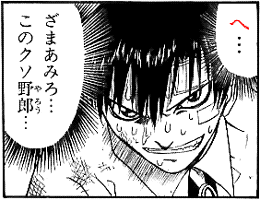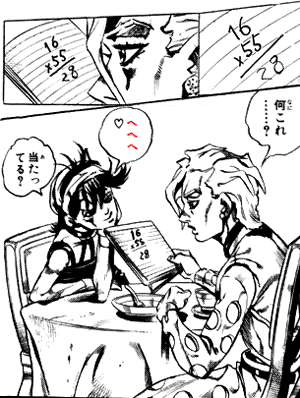Destination
The e へ particle can mark the destination where you're going. For example:- jigoku e iku
地獄へ行く
To go to hell.
In this function, the meaning is practically the same as using the ni に particle.
- jigoku ni iku
地獄に行く
(basically same thing.)
The difference between these two phrases is that the ni に particle vaguely marks the "goal" of the verb, in this case, the goal of "going," which is the destination where you're going.
Meanwhile, e へ vaguely marks the direction toward which an action occurs. It just happens that if you're going "toward" a place, you also end up going "to" the place, so the meanings overlap in some situations.
In particular, note that both of them can mark an adverb directly.
- tooku e ikitai
遠くへ行きたい
Toward far, [I] go want.
[I] want to go to [somewhere] far.- tooku ni ikitai
遠くに行きたい
(practically same meaning.)
- tooku ni ikitai
Sentence-Ending Particle
The e へ particle is ridiculously often found as the last particle of a phrase. Every time it happens, it's because the verb has been omitted. And it has been omitted because it's not necessary, since e へ already gives off the feeling of "to" or "toward."This is the case with the directional pronoun kochira こちら, "this direction," for example.
- kochira e kinasai
こちらへ来なさい
Come toward this direction.
Come toward here.- Used when telling someone to enter inside a room you're pointing toward at, for example, if the room is closer to you than to it's to them.
- kochira e
こちらへ
Toward here. (same meaning.)
This form can even be used to label stuff. For example, say there's a portal in your living room. If you walk through it, you end up in "another world," in an isekai 異世界. There's a sign beside it that reads:
- isekai e
異世界へ
To another world.- i.e. "[this portal goes] to another world."
This is also the case when it comes before youkoso ようこそ, "welcome."
- booru-ruumu e youkoso
ボールルームへようこそ
Welcome to the Ballroom.
More technically, youkoso comes from yoku zo よくぞ.[ようこそ - 大辞林 第三版 via kotobank.jp, accessed 2019-07-17]
The yoku よく part means "well," it's the adverbial form of yoi よい, "good." The zo ぞ part is a particle used for exclamation. And we're still missing a verb.
That means the real identify of e youkoso へようこそ is actually:
- booru-ruumu e yoku zo kita!
ボールルームへよくぞ来た!
Well done by coming to the ballroom!
[You] did well by coming to the ballroom! (that was a good idea!)- kita 来た
To have come [here]. (the missing verb.)
- kita 来た
Toward
In some cases, the e へ particle doesn't mark a destination, but only a general direction "toward" which you're going. This happens with words for the cardinal directions, for example:- higashi e
東へ
Toward the east.- You can go "toward" the east, but you'll never really arrive "at" the east.
Similarly, it can mark "toward" in senses besides geographical direction.
Time
The direction of the e へ particle can the mark the time toward which something happens. For example.- kako kara mirai e
過去から未来へ
From the past, toward the future.
Note that in this case the usage of the e へ particle implies a lack of limit, since made まで could've been used instead to limit the phrase:
- kako kara mirai made
過去から未来まで
From the past, until the future.
From the past, to the future.
In other words, mirai made means it "stops" at the future, while mirai e vaguely progresses endlessly toward the future.
Since normally you don't want to say you "arrive at (and stop at)" the future, you normally don't use made まで, you use e へ: you aren't arriving at the future, you just keep going toward the future.
Addressee
The e へ particle can also mark the addressee of a message or correspondence. For example, say there's a letter:- To whom is it addressed?
- kimi e
君へ
Toward you.
To you.
For you.
Change
The e へ particle can mark toward what something is changing into, or rather, that which something is changing toward. For example:- aka e kawatta
赤へ変わった
Changed toward red.
Changed to red. - otona e nari tsutsu aru
大人へなりつつある
Is becoming toward an adult.
Is turning into an adult.- tsutsu aru
つつある
To be in the process of. (becoming an adult, in this case.)
To be [becoming an adult] step by step, bit by bit, incrementally each time something happens, etc.
- tsutsu aru
Compounds
The e へ particle can combine with the no の particle, forming the e-no への compound. In this case, it's a no-adjective, so no の acts as an attributive copula.- {mirai e no} tabi
未来への旅
A journey [that] {is toward the future}.
A journey toward the future. - {kimi e no} tegami
君への手紙
A letter [that] {is toward you}.
A letter addressed to you. - {kamisama kara jinrui e no} ai
神様から人類への愛
The love [that] {is from God toward the human kind.}
The love of God to the human kind.
The e へ particle can also be combined with the wa は particle, in which case the direction toward becomes the topic of the sentence.
- higashi e wa ikenai
Toward the east, [I] can't go.
Kanji
Like other particles, the e へ is normally written without kanji. However, there are actually two kanji associated with it.辺
Historically, the e へ particle comes from the word he 辺, which means "somewhere around," like in atari 辺り.- sono atari
その辺り
That somewhere-around. (literally.)
That vicinity.
Somewhere around there.
Note that, also historically, he へ was pronounced as e え in the past. Modern language reforms changed the way he へ is supposed to be pronounced, but the particle e へ kept the obsolete "e" pronunciation.
So it makes sense to think that the he 辺 the particle comes from was also pronounced as e 辺 in the past.
江
In correspondence, sometimes the e へ particle is spelled as e 江 when it marks the addressee.This is an ateji 当て字 chosen because the reading of the kanji matches the pronunciation of the particle. That kanji has nothing else to do with the particle.
As for why it happens, that's happens because of the aesthetics of spelling with kanji. In formal situations, using more kanji and less kana is preferred simply because it looks more serious.
Specifically, this is a common pattern when dealing with correspondence:
- Kobayashi yori Tanaka-san e
小林より田中さんへ
By Kobayashi to Tanaka-san.- Kobayashi - sender.
- Tanaka - recipient.
The phrase above is problematic because the particle yori より, the honorific san さん, and the particle e へ, are all spelled with hiragana, and that doesn't look formal enough compared to spelling everything with hard-to-read kanij.
The solution to this is spelling yori より as yori 与利, san さん as san 賛, and e へ as e 江, forming something that looks like:
- A yori B san'e
A与利B賛江 - Kobayashi yori Tanaka san'e
小林与利田中賛江- Absolutely unreadable. Is this Chinese? It's Chinese, right? It looks like Chinese to me.
You can find a photo of it in Real Life™ in this page: 『秋山祐徳太子の母』出版記念展オープニングパーティー gallery-58.jugem.jp, accessed 2019-07-17.
By the way, the reason why the recipient, Tanaka-san, has an honorific, but the sender, Kobayashi, doesn't (it's not Kobayashi-san), is because you don't use honorifics on yourself.
So if Kobayashi sent the correspondence, they couldn't call themselves Kobayashi-san. But another person could say the correspondence is Kobayashi-san yori, "[sent] by Kobayashi-san."
Homonyms
Sometimes, you may see a he へ that's not the e へ particle, but a different word spelled the same way. For reference:Heh
A lone he へ can be just a "heh," someone scoffing at something.
Manga: Zatch Bell!, Konjiki no Gash!! 金色のガッシュ!! (Chapter 5, 道具か人間か!?)
- Context: the antagonist made a mistake. Kiyomaro comments on it.
- he...
へ・・・
Heh... - zamaa miro...
ざまあみろ…- [It servers you right...]
- Expression used toward someone when they make a mistake.
- kono kuso yarou...
このクソ野郎・・・
[You piece of shit].
Heheheh
Sometimes, giggling is represented as hehehe へへへ, or "heheheh."
Manga: JoJo's Bizarre Adventure - Part 5: Golden Wind, JoJo no Kimyou na Bouken: Ougon no Kaze ジョジョの奇妙な冒険 黄金の風 (Chapter 456, 5プラス1)
- Context: Fugo フーゴ gives Narancia ナランチャ a math question to solve.
- 16 × 55 = 28.
- *stares puzzledly.*
- nani kore......?
何これ・・・・・・?
What is this? - hehehe♡
へへへ♡
*giggle* - atatteru?
当たってる?
[Did I get it right]?- Literally "is it hitting," in the sense of hitting the mark, matching the correct answer.
- Also: the i of te-iru is contracted.


No comments: